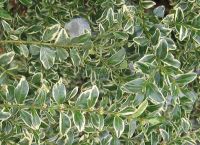Common Box - Buxus sempervirens
English name:
Common Box
Scientific name:
Buxus sempervirens
Family:
Buxaceae (Box)
Height:
Variable, up to 5 M in Denmark
Flowering:
Mid to late April
Range:
Central and S. Europe to Iran and North Africa
 |
|
 |
 |
The 69 year-old Buxus sempervirens in the top picture is from a cutting collected in the Forest Botanic Garden in Charlottenlund, Denmark. This box can be found in square 1211, position 535 within our Tilia collection,. A map with squares and positions can be found on our homepage under: Digital plant search of the Arboretum.
Plant description:
On the grey days in January I always appreciate the evergreen plants in our collection that reduce the dreariness of the landscape. My personal bias is that more use should be made of evergreen trees and bushes in Danish landscaping. This months plant, Buxus sempervirens, is a one of the earliest evergreen plants to be used in Danish gardens. Still popular, it has often been used for formal hedging, for example in the fabulous Baroque garden at Frederiksborg Castle.
The genus Buxus has more than 30 species. It is a widely distributed genus, occurring in temperate to tropical zones in Europe, Africa, Asia and Central America and the West Indies. We have 3 species in our collection: B. hyrcana, B. microphylla, and B. sempervirens. There are 38 examples of Buxus sempervirens. Most of our specimens are of garden origin, but our 10 wild collected specimens come from France, Spain, and Greece.
Buxus sempervirens was in Denmark as early as the year 1510. By 1856, a number of named varieties were already being grown in the Hørholm nursery. The variegated varieties probably were first introduced to Denmark a bit later in the 1800s by among others, the Forest Botanic Garden in Charlottenlund. Our oldest registered examples of the common box (cultivar Arborescens) were made from cuttings taken in the Forest Botanic Garden in 1934.
Buxus sempervirens is an evergreen, bush or small tree. The twigs are angled. They are green in the first few years and have cream coloured hairs. The opposite evergreen leaves are hard, leathery elliptic, 2-3 cm long with entire margins. They are shinny dark green on the upper surface and a mat, pale green on the lower surface. The petiole is has cream coloured hairs. Interestingly it is possible to peal the lower, light-green part away from the upper surface after first breaking a leaf in half. Flower buds are tightly grouped in the axels of the leaves. The flowers are single sexed with the terminal female flower (with three short styles) in the middle of 5 to 6 male flowers (each with 4 stamens). The fruit is a three sided capsule with horns and shoots out the black seed upon opening.
This is a well known and useful garden plant because it tolerates pruning so well and because of the evergreen, shinny leaves. Some varieties are quite drought tolerant. A large number of cultivars are available and new ones named every year. All parts of the plant are poisonous. Fortunately this makes it resistant to deer browsing.
Interestingly the smell of box is said to attract dogs, that in turn burn the leaves with their urine. Planting it in places where male dogs regularly visit, may be problematic. The wood of box is twice as hard as oak and polishes well. It has had many uses including the making of rulers, combs, printing blocks, croquet balls, gun butts, furniture decorations and musical instruments.
References:
Jensen, V., Paludan, H.K., Sørensen, C.Th. (eds.) 1948. Buske og Træer (Bushes and Trees). Emil Wienes Bogforlag 551 pp.
Lange, J. 1994. Kulturplanternes Indførselshistorie i Danmark. (Introduction History of Cultivated Plants in Denmark). Jordbrugsforlaget, Frederiksberg. 458 pp.
Mabberley, D.J. 1998. The Plant Book. The Bath Press, Bath, 858 pp.
Mitchell, A. & Ødum S. 1983. Træer i Nordeuropa (Trees in Northern Europe). Gads Forlag, Copenhagen, pp. 413pp.
Olsen, O. et al. 1997 Havens Planteleksikon. Træer og Buske. (Danish Plant Encyclopaedia, Trees & Bushes). Det Danske Haveselskab Publisher, 674 pp.
Rushforth, K. 1999. Trees of Britain and Europe. Harper Collins Publisher. 1336 pp.
Plants for a Future Web page: http://pfaf.org/user/Plant.aspx?LatinName=Buxus+sempervirens
